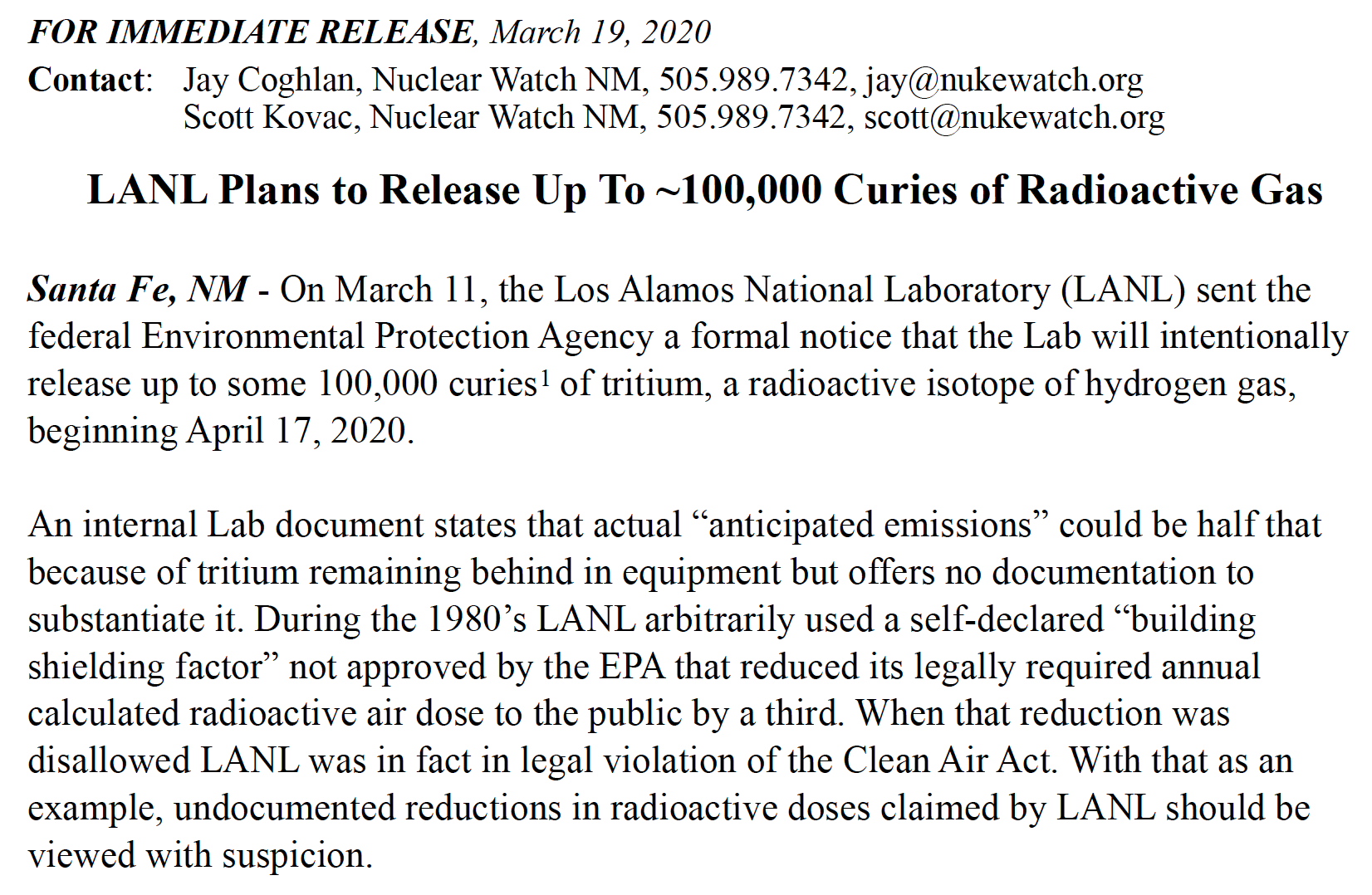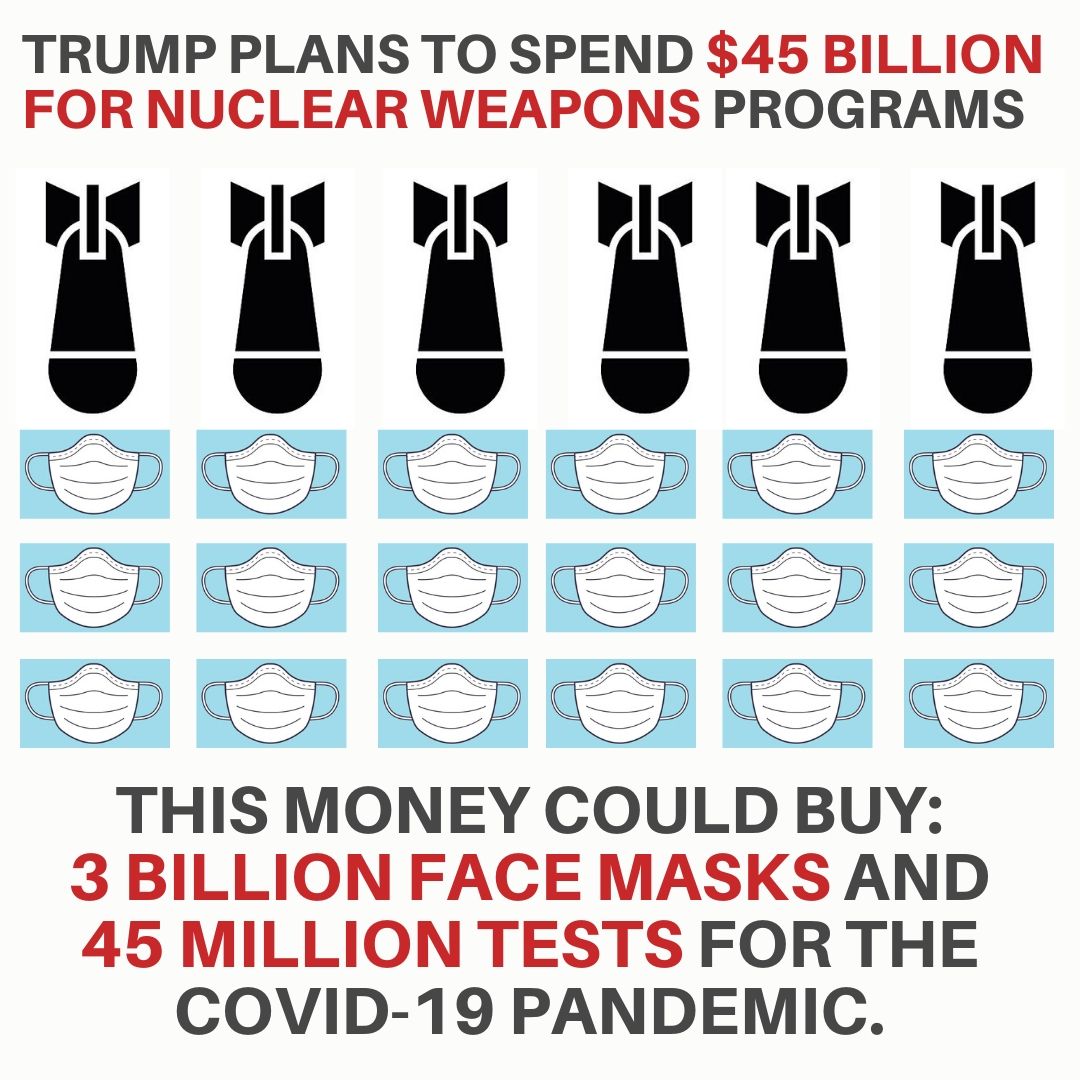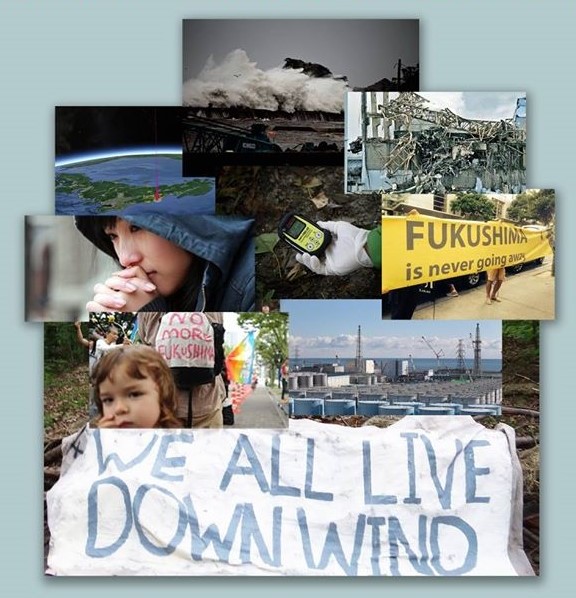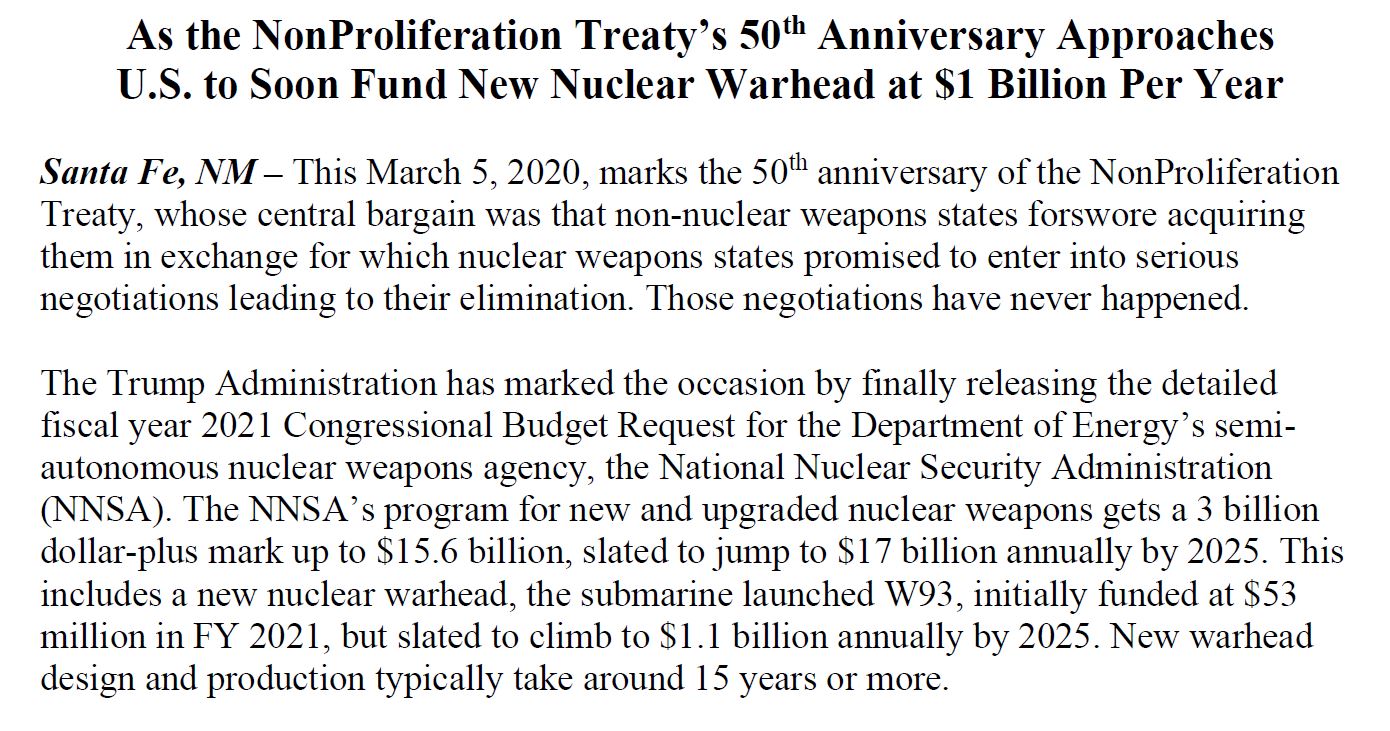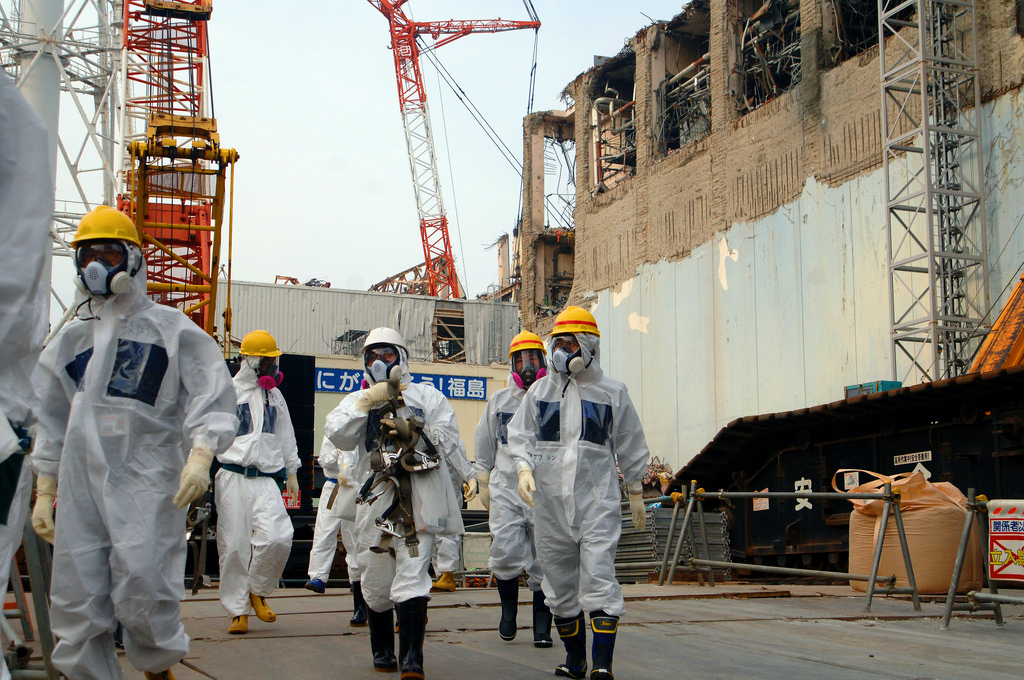2020
More Information on Tritium’s Significant Hazards
Routine Radioactive Releases from U.S. Nuclear Power Plants. An update to our comprehensive list and map of all operating U.S. reactors and where they release radioactivity into the air and water. Every nuclear power reactor dumps radioactive water, scatters radioactive particles, and disperses radioactive gases as part of its routine, everyday operation. It doesn’t take an accident. Federal regulations permit these radioactive releases. Any exposure to radiation increases the risk of damage to tissues, cells, DNA, and other vital molecules, potentially causing genetic mutations, cancers, leukemias, birth defects, and reproductive, cardiovascular, endocribe, and immune system disorders.
The pamphlet lists all reactors operating at the October 2015 press time. For an up to date track of reactors as they close, please visit our Reactors Are Closing page
[This pamphlet is broader than just tritium, but tritium plays a significant part. See especially the discussion of how hazardous even a couple of curies of hazardous radioactivity, badly handled, can be.]
Reports
Leak First, Fix Later: Uncontrolled and Unmonitored Radioactive Releases from Nuclear Power Plants
UPDATED!
Leak First, Fix Later: Uncontrolled and Unmonitored Radioactive Releases from Nuclear Power Plants. May 2015. Newly revised and updated from the original, Leak First is a Beyond Nuclear report on the persistent and ongoing leaking of radioactive effluent into ground and surface water from uninspected and unmaintained buried piping under every nuclear power plant.
UPDATED!
Executive Summary. May 2015.
Note: New leaks occur often and at multiple nuclear reactor sites. Watch this page for updates on new leaks and spills.
LANL waste is unearthed at housing site
A utility crew found hazardous waste buried on land the U.S. Energy Department had transferred to Los Alamos County, stalling work on an affordable housing project.
ARTICLE BY: SCOTT WYLAND | santafenewmexican.com
The discovery of low-level radioactive waste 7 to 12 feet in the ground off DP Road last month prompted the state Environment Department to write a letter that ordered the agency to supply more information about the waste, how it got there and how the agency planned to avoid future incidents.
The state agency is “extremely concerned” about the contamination unearthed on a former Los Alamos National Laboratory site and “the potential threat to human health and the environment,” wrote Kevin Pierard, the department’s Hazardous Waste Bureau chief, in a Feb. 28 letter.
Pierard demanded Energy Department and lab officials submit data on the site and the sources of contamination, as well as tests and investigations that were conducted.
“We are currently investigating and characterizing the waste located at the site to determine the extent of the contamination,” Energy Department managers wrote in response.
The waste was placed in three drums and moved to another site for further analysis, the Energy Department said. Crews have fenced off the construction site, covered it with tarp and posted signs to keep people out, the letter said.
Political Battle Brewing Over New Nuclear Program
“Congressional leadership has yet to receive the military requirement or justification for another new nuclear warhead,” a spokesperson for HASC Democrats said in an email.
“As recently as July 2019, the Department of Energy projected it would begin work on this warhead in 2023. Work on this new warhead will add billions of dollars to an already strained nuclear modernization plan.”
BY JON HARPER | nationaldefensemagazine.com
The Trump administration’s proposal to begin work on a new nuclear warhead program to modernize the nation’s aging stockpile is expected to be hotly contested.
For fiscal year 2021, President Donald Trump requested $28.9 billion for the Pentagon’s nuclear enterprise. He requested an additional $15.6 billion for efforts by the National Nuclear Security Administration, which manages the stockpile, including $53 million for NNSA work on a new warhead, dubbed the W93.
What is real national security? Comprehensive public health or more nuclear weapons?
Public Health as a National Security Concern
“Different perspectives on what “security” means compete for attention, and the literature that brings public health and national security together forces those in public health to contemplate these different perspectives and how they relate to the public health mission of protecting population health.” — Fidler, David P., “Public Health and National Security in the Global Age: Infectious Diseases, Bioterrorism, and Realpolitik”
“Nuclear power robbed us of everything. We still can’t go into the forests. Families with children used to go into the forest to gather wild plants and teach about nature. That was a common practice, taken for granted. But today we can’t do any of that.” — Kenichi Hasegawa, a former dairy farmer in Namie Town, Fukushima

Nine years have passed since the Great East Japan Earthquake and tsunami struck the Tohoku region on March 11, 2011, causing the ensuing accident at the Fukushima Daiichi nuclear power plant. The effects of this disaster are ongoing: radiation contaminated a large area and has had serious impacts on the environment and the livelihoods that depended so much on the natural environment.
With sadness but no ceremony, Japan marks disaster anniversary
Report: Nuclear waste cleanup efforts could be delayed
“It is shocking that DOE would propose to delay projects like the cesium-strontium capsules and the 324 Building contamination, which pose such great risks to the workers and public,” said Tom Carpenter, executive director for Hanford Challenge, a watchdog and worker advocacy group.
THE ASSOCIATED PRESS | sanluisobispo.com
The Department of Energy has announced priority plans for environmental cleanup nationwide and indicates a slower process for the decommissioned nuclear site in Washington state, a report said.
The focus at the Hanford Site will be to start treating waste at the $17 billion vitrification plant, but the report does not detail other work at the 580-square-mile (1,500-square-kilometer) site, the Tri-City Herald reported Tuesday.
The report does not mention moving radioactive capsules to safer storage and cleaning up a radioactive spill under one of the buildings a mile north of Richland.
9th Anniversary of Fukushima Daiichi Nuclear Disaster
Nine years have passed since the Great East Japan Earthquake and ensuing tsunami struck the Tohoku region on March 11, 2011, causing the disastrous accident at the TEPCO Daiichi nuclear power plant. The impacts of this nuclear disaster continue to this day.
We join together with people around the world to stand with the victims and continue working towards a peaceful world without nuclear power and nuclear weapons.
Public invited to comment on LANL impact statement
“NNSA [is] shutting the public out, while steamrolling exorbitantly expensive expanded pit production…There is a clear need for a nationwide programmatic environmental impact statement to justify or not expanded plutonium pit production, followed by a new site-wide environmental impact statement for Los Alamos,” — Jay Coghlan, Nuclear Watch New Mexico
BY T.S. LAST | abqjournal.com Copyright © 2020 Albuquerque Journal
SANTA FE – The National Nuclear Security Administration on Tuesday released its draft Supplement Analysis to the 2008 Site-wide Environmental Impact Statement for Los Alamos National Laboratory, concluding that it doesn’t have to complete an environmental impact statement.
The study examines whether environmental analysis for expanded plutonium pit production at LANL should be required under the National Environmental Policy Act.
“Based on analysis in this SA, NNSA preliminarily concludes that no further National Environmental Policy Act documentation for LANL at a site-specific level is required,” the document says. “However, NNSA will consider comments on this draft SA prior to publishing a final SA.”
“Proud to be an American?” What an American admiral forgets about nuclear war
“Today, all these years later, the Trump administration is much more focused on acquiring new nuclear weapons systems than constraining or eliminating them. And the White House seems all too eager to walk away from the treaties and tools that were built to reduce these weapons’ greatest risks.”
MONICA MONTGOMERY | thebulletin.org
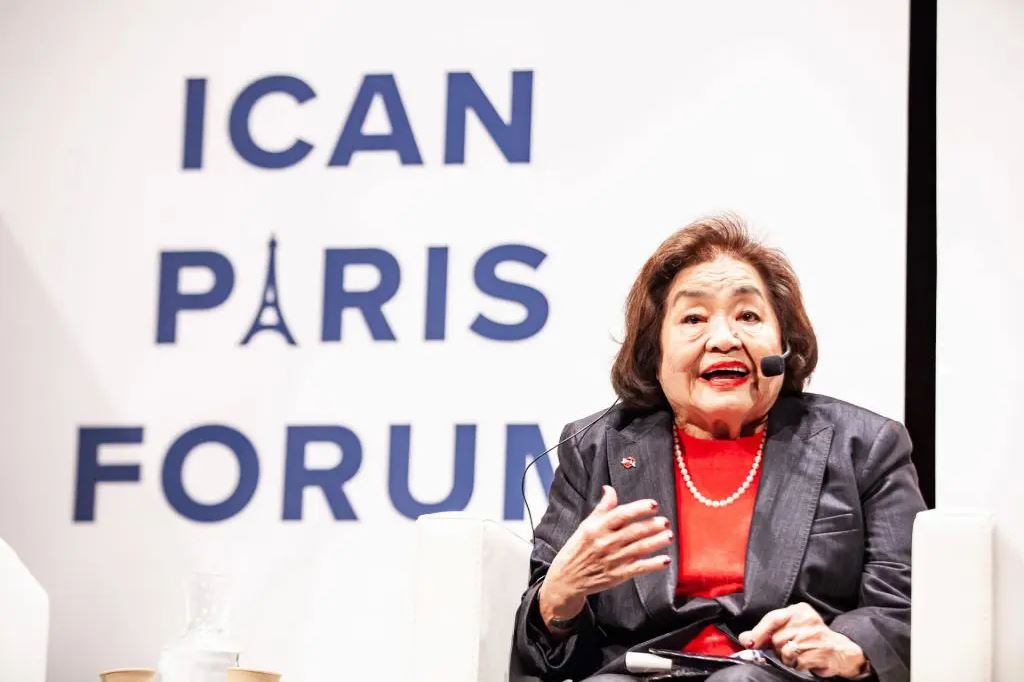
In late February, Adm. Charles Richard, head of US Strategic Command, told a House committee that the innovations going into a new nuclear warhead are what make him “proud to be an American.”
He was referring to the W93, a new nuclear warhead that will be used on submarine-launched ballistic missiles and that the Trump administration wants $53 million to start work on this year. While the design and timeline remain unclear, the administration forecasts that the price tag for developing and building this new weapon will reach over $1 billion per year in the next four years. The W93 would join or replace at least three other submarine-launched nuclear warheads that already exist and for which billions already have been and are still being spent to modernize.
Energy Dept. Nearly Triples Funding for Plutonium Pit Production, Cuts Cleanup in Half – But Refuses to Complete New Env. Impact Statement for Los Alamos Lab
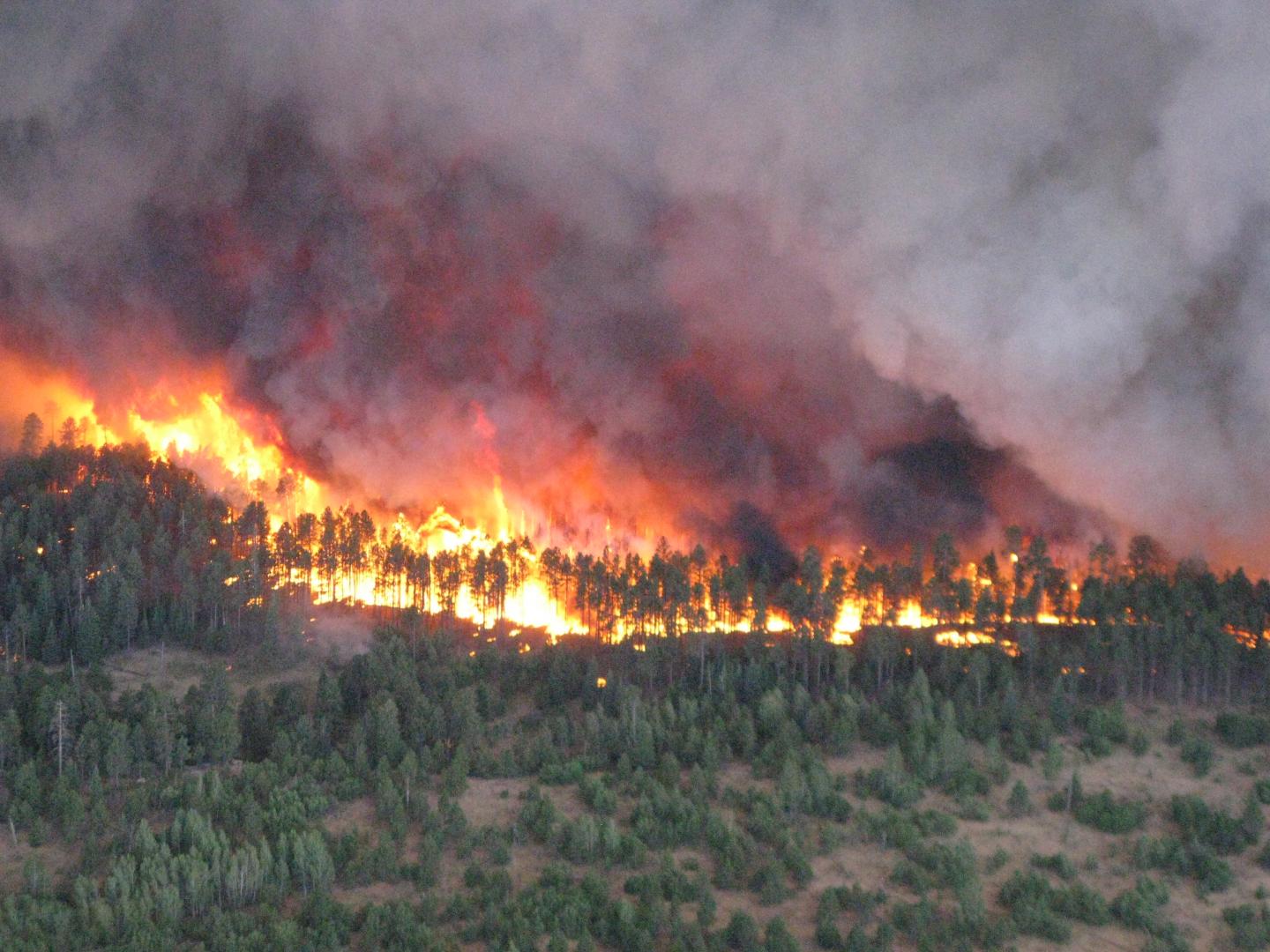
Santa Fe, NM – Today the Department of Energy’s semi-autonomous nuclear weapons agency, the National Nuclear Security Administration (NNSA), announced that it will not complete a new site-wide environmental impact statement for the Los Alamos National Laboratory (LANL). The last site-wide environmental impact statement was in 2008.
Since that time a catastrophic wildfire burned to the western boundary of the Lab (likely to occur more frequently with climate change); an exploding radioactive waste drum improperly prepared by LANL shut down the Waste Isolation Pilot Plant for three years, costing taxpayers ~$3 billion to reopen; the full extent and depth of a hexavalent chromium plume contaminating the regional groundwater is still not fully determined; and LANL’s long track record of chronic nuclear safety incidences remain unresolved.
Non-Proliferation Treaty turns 50 as US funds new nukes
“You can’t preach temperance from a bar stool, you can’t tell others not to have nuclear weapons when you’re busy ‘modernizing’ your own.”
ARTICLE BY: JAY COGHLAN / NUCLEAR WATCH NEW MEXICO | abqjournal.com
Thursday marked the 50th anniversary of the Non-Proliferation Treaty, whose central bargain was that non-nuclear weapons states forswore acquiring them in exchange for which nuclear weapons states promised to enter into serious negotiations leading to their elimination. Those negotiations have never happened.
The Trump Administration has marked the occasion by finally releasing the detailed fiscal year 2021 Congressional Budget Request for the Department of Energy’s semi-autonomous nuclear weapons agency, the National Nuclear Security Administration. The NNSA’s program for new and upgraded nuclear weapons gets a $3 billion-plus mark-up to $15.6 billion, slated to jump to $17 billion annually by 2025.
Sandia Labs may get $300 million budget increase
Meanwhile, “[Los Alamos] laboratory’s funding for the cleanup of radioactive waste it produced during the Manhattan Project and Cold War would decrease by $100 million.”
SCOTT TURNER | abqjournal.com Copyright © 2020 Albuquerque Journal
Sandia National Laboratories would receive a $300 million increase in federal funding under President Donald Trump’s proposed fiscal 2021 budget.
Most of the increase involves the labs’ nuclear weapons program, Sandia officials told the Journal.
Progressive lawmakers waging new NDAA fight
“This administration has no regard for Congress, and unless we put in very strict parameters around our funding support and our authorization, they’re just going to continue to roll all over us.” – Rep. Pramila Jayapal (D-Wash.), co-chair of the Congressional Progressive Caucus
Progressive House Democrats are eyeing a new push to roll their top agenda items into the National Defense Authorization Act this spring, Connor O’Brien reports, as they seek to seize on support for their legislation but also anxiety over Trump’s expansive war powers and his diversion of military funding for the border wall.
The left wing of the Democratic caucus is still smarting after feeling they got rolled on attempts to block a military confrontation with Iran, head off a shift in Pentagon funds toward the border wall, limit nuclear weapons spending, reverse restrictions on transgender troops and withdraw U.S. military support in Yemen’s civil war.
“They note that not long after last year’s bill failed to require Congress to sign off on war with Iran, repeal the 2002 Iraq war authorization and limit Trump’s ability to move money, Trump ordered the killing of a top Iranian commander and moved to sap billions more from the Pentagon’s coffers for the wall,” O’Brien reports.
LANL Budget Increased by Nearly $1 Billion to Accelerate Work As Production Site for Nuclear Weapons Designs by Livermore Lab Cleanup Cut by 46%
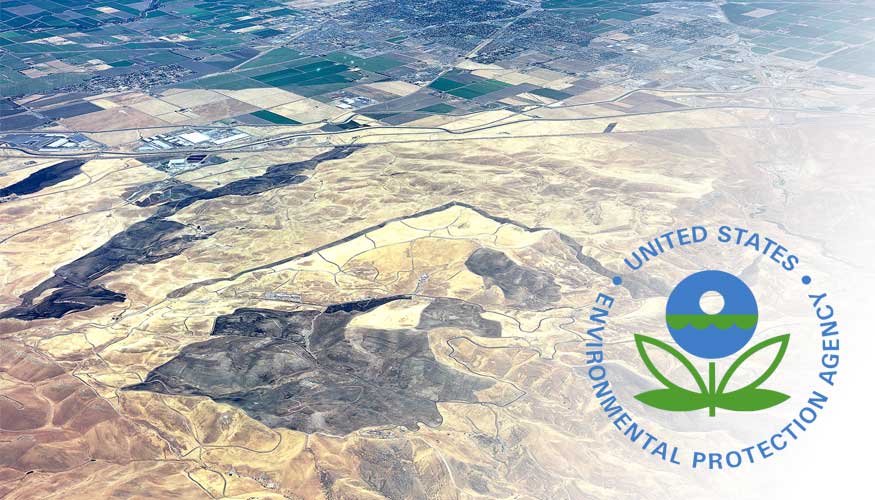
Santa Fe, NM – The Trump Administration has released more budget details for its proposed Fiscal Year 2021 federal budget for the Department of Energy and its semi-autonomous nuclear weapons agency, the National Nuclear Security Administration (NNSA). The Los Alamos National Laboratory (LANL) is slated to receive nearly a one billion dollar increase for its nuclear weapons programs (up 48%), overwhelmingly for new production. At the same time cleanup, whose need is caused by nuclear weapons production, is cut by 46%.
Significantly, LANL’s FY 2021 budget for design work of nuclear weapons stayed flat after falling by 28% from FY 2018 to FY 2019. Meanwhile, funding for nuclear weapons design work at the Lawrence Livermore National Laboratory more than doubled from FY 2019 to FY 2021.
As the NonProliferation Treaty’s 50th Anniversary Approaches U.S. to Soon Fund New Nuclear Warhead at $1 Billion Per Year
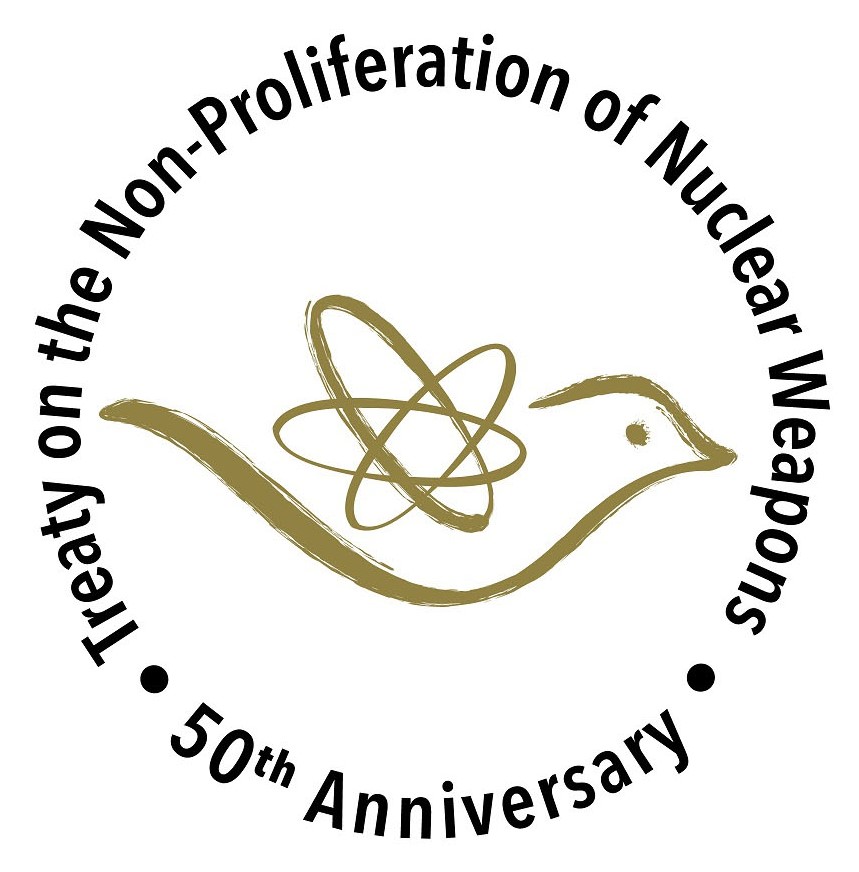
Santa Fe, NM – This March 5, 2020, marks the 50th anniversary of the NonProliferation Treaty, whose central bargain was that non-nuclear weapons states forswore acquiring them in exchange for which nuclear weapons states promised to enter into serious negotiations leading to their elimination. Those negotiations have never happened.
The Trump Administration has marked the occasion by finally releasing the detailed fiscal year 2021 Congressional Budget Request for the Department of Energy’s semi- autonomous nuclear weapons agency, the National Nuclear Security Administration (NNSA). The NNSA’s program for new and upgraded nuclear weapons gets a 3 billion dollar-plus mark up to $15.6 billion, slated to jump to $17 billion annually by 2025. This includes a new nuclear warhead, the submarine launched W93, initially funded at $53 million in FY 2021, but slated to climb to $1.1 billion annually by 2025. New warhead design and production typically take around 15 years or more.
The White House gave this nuclear agency a giant funding increase. Can it spend it all?
“The proposed $3.1 billion increase for weapons is simply sprinting toward failure, and Congress should right-size NNSA’s workload to match what the complex can realistically do,” – Rep. Marcy Kaptur, D-Ohio
ARTICLE BY: AARON MEHTA | defensenews.com
WASHINGTON — Members of Congress used a hearing Tuesday to question whether the National Nuclear Security Administration, a semiautonomous arm of the Department of Energy that handles development of nuclear warheads, can spend an almost 20 percent funding increase requested by the Trump administration.
Joint Declaration between the Anishinabek Nation and the Iroquois Caucus on the Transport and Abandonment of Radioactive Waste
Preamble
The Anishinabek Nation and Iroquois Caucus have renewed their relationship and commitment of unity by smoking the sacred pipe. The two nations have met to discuss radioactive waste matters that are within their traditional and treaty territories
Central to the discussions were ceremony, and spirituality, as reflected in our inherent responsibilities and intimate relationship to the land, waters, and all our relations.
We the Anishinabek Nation and Iroquois Caucus have jurisdiction over the Great Lakes and St. Lawrence River basins as a result of Aboriginal titles, and the treaties that have been entered into by First Nations and the Crown. We have our own territories and exercise our jurisdiction on a Nation-to-Nation basis.
Heinrich grills energy secretary on proposed $100M budget cut for LANL cleanup
“I can’t understand why this administration does not value cleanup and would risk breaking the legal commitments [the Department of Energy] has made to the state of New Mexico with budget numbers like that,” Heinrich said. “Why is the cleanup number so abysmal in this budget?”
ARTICLE BY: SCOTT WYLAND | santafenewmexican.com March 3, 2020
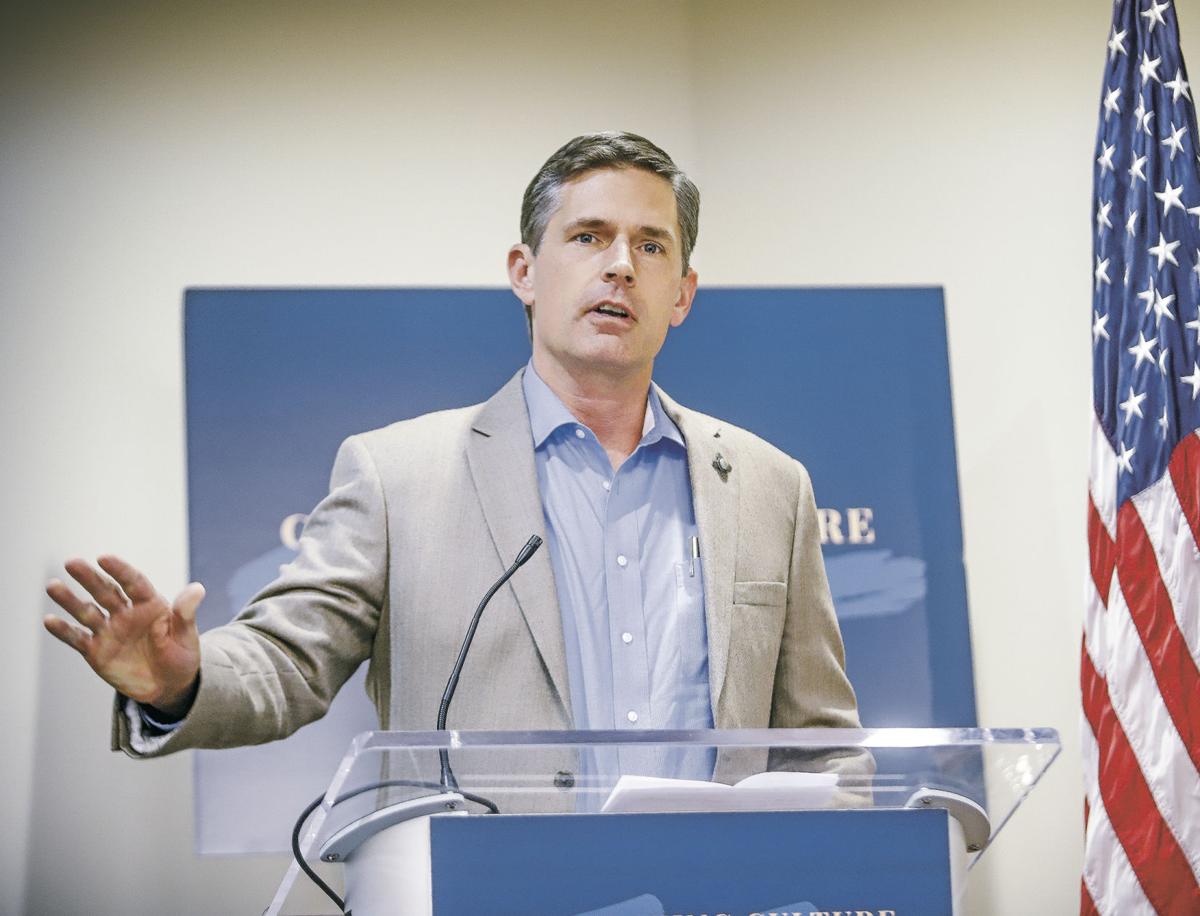
U.S. Sen. Martin Heinrich fired tough questions and caustic comments at Energy Secretary Dan Brouillette on Tuesday over the proposed $100 million cut in Los Alamos National Laboratory’s cleanup program for radioactive waste it produced during the Manhattan Project and Cold War.
Nuclear Tests Marked Life on Earth With a Radioactive Spike
Even as it disappears, the “bomb spike” is revealing the ways humans have reshaped the planet.
STORY BY: CARL ZIMMER | theatlantic.com
On the morning of March 1, 1954, a hydrogen bomb went off in the middle of the Pacific Ocean. John Clark was only 20 miles away when he issued the order, huddled with his crew inside a windowless concrete blockhouse on Bikini Atoll. But seconds went by, and all was silent. He wondered if the bomb had failed. Eventually, he radioed a Navy ship monitoring the test explosion.
“It’s a good one,” they told him.
Then the blockhouse began to lurch. At least one crew member got seasick—“landsick” might be the better descriptor. A minute later, when the bomb blast reached them, the walls creaked and water shot out of the bathroom pipes. And then, once more, nothing. Clark waited for another impact—perhaps a tidal wave—but after 15 minutes he decided it was safe for the crew to venture outside.
The mushroom cloud towered into the sky. The explosion, dubbed “Castle Bravo,” was the largest nuclear-weapons test up to that point. It was intended to try out the first hydrogen bomb ready to be dropped from a plane.
Senators ask government watchdog to assess NNSA’s nuclear weapons spending
Read the letter here
BY: COLIN DEMAREST | aikenstandard.com
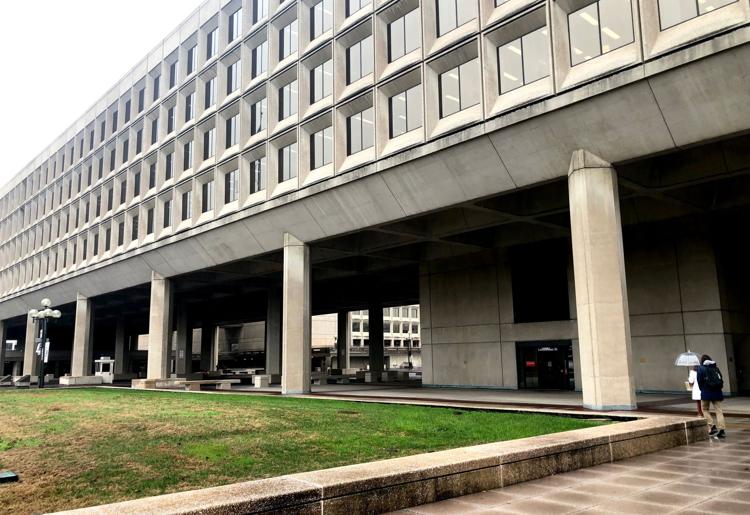
Two prominent Democratic senators have asked a congressional watchdog to examine the National Nuclear Security Administration’s nuclear weapons spending and related workload.
The request comes a little more than two weeks after President Donald Trump unveiled his fiscal year 2021 budget request, which included $19.8 billion for the semiautonomous U.S. Department of Energy agency, $15.6 billion of which is flagged for nuclear weapons work.
That’s 25.2% above the fiscal year 2020 enacted level.
“Questions about affordability are critical given the significant expansion in NNSA’s budget and activities,” U.S Sens. Dianne Feinstein of California and Ed Markey of Massachusetts wrote in their Feb. 27 letter to the Government Accountability Office.
“The GAO raised concerns in a 2017 report about the affordability of NNSA modernization efforts,” the letter also reads, “and NNSA’s budget and activities have expanded significantly since that time.”
The independent accountability office investigates and issues reports often, touching everything from agriculture and food to national defense and tax policy.
GOP lawmaker accuses administration of ‘playing politics’ with Yucca Mountain reversal
“The Trump Administration again proposes to cut DOE’s budget — by 8 percent overall, and by an astounding 35 percent in non-defense programs. This will limit America’s future by drastically reducing or eliminating programs critical for meeting our future energy needs and assuring our security,” – Rep. Marcy Kaptur (D-Ohio), chairwoman of the Appropriations Committee’s subcommittee on Energy and Water Development
ARTICLE BY: RACHEL FRAZIN | thehill.com
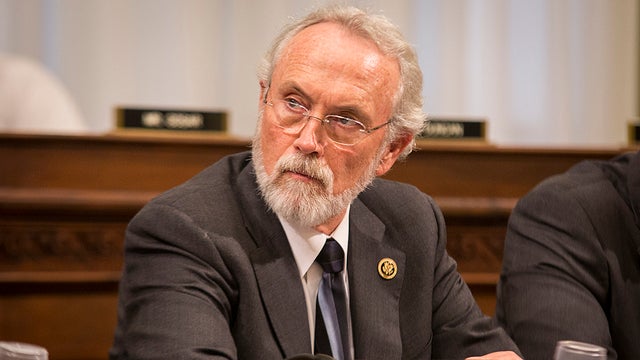
Republican Rep. Dan Newhouse (Wash.) accused the Trump administration of “playing politics” on Thursday with its reversal on funding for a nuclear waste repository in Nevada.
“I can’t tell you how disappointed I was to see this administration playing politics with something as important as completing the permanent solution to our nation’s high-level nuclear waste,” Newhouse said during a hearing on the administration’s proposed Department of Energy (DOE) budget.
“This budget is … a total waste of resources and a distraction from solving this very important issue,” he added.
President Trump announced this month that he no longer supports funding the Yucca Mountain nuclear waste site, reversing his position on a controversial matter in a key state in November’s elections. The change was reflected in his budget proposal for fiscal year 2021.
Energy Secretary Dan Brouillette said during the hearing that the administration would not proceed with either licensing for Yucca Mountain or an interim storage facility.
“My understanding [is] under the Nuclear Waste Policy Act we are prohibited from starting construction on an interim facility, a federal facility,” Brouillette said.
Democrats also criticized the administration over cuts included in the budget proposal.
“The Trump Administration again proposes to cut DOE’s budget — by 8 percent overall, and by an astounding 35 percent in non-defense programs. This will limit America’s future by drastically reducing or eliminating programs critical for meeting our future energy needs and assuring our security,” said Rep. Marcy Kaptur (D-Ohio), chairwoman of the Appropriations Committee’s subcommittee on Energy and Water Development, in her opening statement.
“Your budget proposes deep and arbitrary cuts that threaten progress one one of our most pressing challenges and that is climate change. We can be a leader in exporting clean energy technologies, but not under your budget request,” Kaptur added later in the hearing.
In response, Brouillette said, “Renewable technologies are becoming somewhat mature in the marketplace, so for us to focus again on these technologies that are now commercially widely available seems to us to be inappropriate.”
Trump’s budget request would reduce spending significantly at several energy and environment-related agencies, including the energy department. Trump has consistently proposed cutting funding such agencies, and Congress has routinely ignored those proposals and instead increased funding.
NNSA should focus on cleanup
Before we break out the champagne, we should ask serious questions because budgets are more than just numbers on a page. They also tell us about priorities.
BY: RALPH HUTCHINSON | oakridger.com
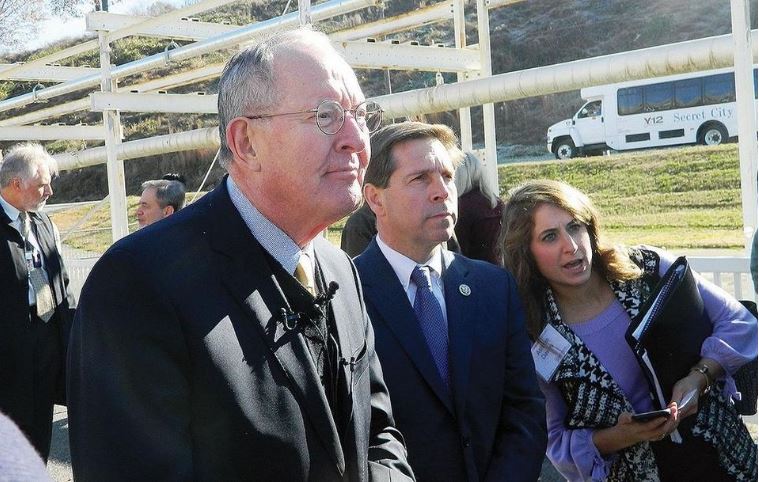
U.S. Sen. Lamar Alexander (R-Tenn.), from left, and U.S. Rep. Chuck Fleischmann, (R-Tenn.) are pictured with Ashton Davies of the senator’s press office during a well-attended ceremony held in Oak Ridge, Tenn., on Nov. 20, 2017, to break ground on the construction of a new Mercury Treatment Facility to deal with runoff from the Y-12 site – Ben Pounds/The Oak Ridger
In an op-ed on Feb. 7, Lisa Gordon-Hagerty, the head of National Nuclear Security Administration, made her argument for the new Trump Administration’s Fiscal Year2021 budget request (“Modernizing our nuclear enterprise infrastructure to keep Americans safe”). In it she reminds us of the billions of dollars being spent here on nuclear weapons projects and celebrates the whopping 20% proposed increase for the NNSA system, including in Oak Ridge.
BOOM Goes the Budget as DOE Plans for Nuclear War: $4.6 Billion Target for Unjustified Plutonium Bomb Plant (PBP) at $R$
DOE Plans for $4.6 Billion Cost to Convert the Ill-Constructed MOX Plant into a Plutonium Bomb Plant (PBP) at Savannah River Site by 2026-2030; Money to be Spent on Top of $8 Billion Wasted on MOX
BY: TOM CLEMENTS | srswatch.org
Plan to Seek $442 Million for PBP in Fiscal Year 2021 Confirmed in Feb. 26 Budget Document
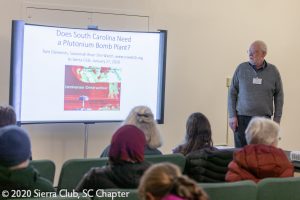 Columbia, South Carolina – A budget document released by the U.S. Department of Energy late on Wednesday, February 26 reveals that the agency has assumed a stunning projected cost of $4.6 billion to convert the poorly constructed plutonium fuel (MOX) building at the Savannah River Site into a Plutonium Bomb Plant (PBP). This amount of spending reveals that DOE and contractors aim to repurpose the failed MOX project into a perpetual money machine, according to the public interest group Savannah River Site Watch.
Columbia, South Carolina – A budget document released by the U.S. Department of Energy late on Wednesday, February 26 reveals that the agency has assumed a stunning projected cost of $4.6 billion to convert the poorly constructed plutonium fuel (MOX) building at the Savannah River Site into a Plutonium Bomb Plant (PBP). This amount of spending reveals that DOE and contractors aim to repurpose the failed MOX project into a perpetual money machine, according to the public interest group Savannah River Site Watch.
The budget document, the National Nuclear Security Administration’s funding request to Congress for Fiscal Year 2021, confirms that the agency is seeking $441 million for “repurposing” the MOX building into the unjustified Plutonium Bomb Plant.
US wants new nuclear weapons to counter Russia but says there is no arms race
Defense Department has pushed back on the notion that the US is engaging in an arms race or growing its nuclear arsenal, saying its latest moves are merely a response to Russian efforts
BY: RYAN BROWNE | cnn.com
Washington (CNN) During a visit to US Strategic Command last week, Secretary of Defense Mark Esper oversaw a “table top” war game exercise where Russian military forces used a “tactical” nuclear weapon against NATO territory during a conflict in Europe, prompting the US to launch a retaliatory nuclear strike.
“The scenario included a European contingency where you are conducting a war with Russia and Russia decides to use a low yield limited nuclear weapon against a site on NATO territory and then you go through the conversation that you would have with the Secretary of Defense and the President ultimately, to decide how to respond,” a senior Department of Defense official told reporters Friday.
2019
A terrifying new animation shows how 1 ‘tactical’ nuclear weapon could trigger a US-Russia war that kills 34 million people in 5 hours
- A new simulation called “ Plan A,” by researchers at Princeton’s Program on Science and Global Security, shows how the use of one so-called tactical or low-yield nuclear weapon could lead to a terrifying worldwide conflict.
- In the roughly four-minute video, a Russian “nuclear warning shot” at a US-NATO coalition leads to a global nuclear war that leads to 91.5 million deaths and injuries.
- Under President Trump, the US is ramping up production of tactical nuclear weapons, ostensibly to target troops and munitions supplies. While advocates say these weapons would keep wars from escalating, the simulation finds the opposite outcome.
- The dissolution of the INF treaty in August raised the stakes for nuclear war, as both the US and Russia were free to develop weapons previously banned under the treaty.
- “The risk of nuclear war has increased dramatically in the past two years,” the project states. Nuclear strikes are an extremely remote possibility, but their chances are rising experts warn.
More than 91 million people in Russia, the US, and NATO-allied countries might be killed or injured within three hours following a single “nuclear warning shot,” according to a terrifying new simulation.
European Leadership Network Group Statement on Nuclear Arms Control
Ahead of the 74th session of the United Nations General Assembly, over 100 members of the European Leadership Network’s network of political, diplomatic and military figures call on leaders at UNGA to address rising nuclear risk, and renew commitments to international nuclear diplomacy and arms control.
The full statement and list of signatories is reproduced in English below, and is also available in French, German, Italian, and Russian. ************
As world leaders prepare to meet this month at the United Nations in New York, we call on them to take urgent steps to reduce the risks of nuclear confrontation. We join a growing number of international leaders in raising the alarm over new nuclear dangers.
Last month we witnessed the end of the landmark US-Russia Intermediate Nuclear Forces Treaty (INF). Today, there are grave doubts over the future of the only remaining agreement that limits and regulates Washington and Moscow’s strategic nuclear weapons, the New Strategic Arms Reduction Treaty (START). And new challenges confront the Comprehensive Nuclear-Test-Ban Treaty (CTBT).
Stability is eroding and risks are rising. North Korea has grown its nuclear weapon stockpile, tests missiles, and continues to feel threatened. The fate of inter-Korean and US-DPRK dialogue remains uncertain. Tensions are flaring between nuclear rivals India and Pakistan. And, following Washington’s unilateral breach and resumed sanctions, Iran may walk away from the nuclear deal that constrains its ability to develop nuclear weapons.
Moreover, new military technologies threaten to destabilise global and regional nuclear confrontations. These technologies are rapidly evolving and entirely uncontrolled.
The risks of nuclear accident, misjudgement or miscalculation have not been higher since the Cuban Missile Crisis. Complacency should not be an option. It is not only European security at stake.
The Catastrophic Tenure Of John Bolton
“The national security adviser’s principal responsibility has traditionally been to oversee a disciplined policymaking process that includes the State Department, the Pentagon and intelligence agencies, and to tee up big decisions for the president,” editorialized The Washington Post the night of Bolton’s firing, “Mr. Bolton didn’t do that.”
BY JOE CIRINCIONE | lobelog.com Sep. 11, 2019
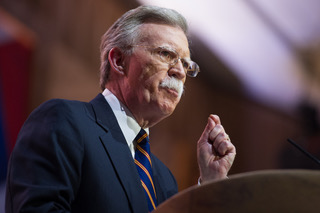
Seventeen months ago, before Bolton became Donald Trump’s third national security advisor, the United States still had a deal that had stopped Iran’s nuclear program in its tracks. More, it had rolled it back to a fraction of its original size and boxed it into the most intrusive inspection regime ever negotiated. It was a deal for the ages. All of Trump’s military, intelligence and security advisors and our closest allies urged Trump to stay in the accord. Bolton destroyed it in two months, pushing Trump to violate it and impose draconian sanctions on Iran.
“Withdrawing from the Iran Nuclear Deal should be a top Donald Trump administration priority,” Bolton tweeted in July 2017, months before his appointment. “The declared policy of the United States should be the overthrow of the mullahs’ regime in Tehran,” he shouted at an MEK rally in July 2017, promising them that they would all celebrate in Tehran “before 2019.”
Today, Iran is slowly pealing away from the deal, too, taking baby steps towards restarting capabilities that someday could allow it to make the material for a bomb, should it decide to do so. No new deal. No better deal. No regime change. No celebration in Tehran. “Trump has spent years making a mess of Iran policy for no reason other than right wing politics and incompetence,” tweeted former Deputy National Security Advisor Ben Rhodes as news of Bolton’s sacking spread.
California lawmaker aims to stop closure of Diablo Canyon nuclear plant
Assemblyman Jordan Cunningham, R-Templeton (San Luis Obispo County), on Wednesday proposed a state constitutional amendment that would designate nuclear power as a source of renewable energy.
BY J.D. MORRIS | sfchronicle.com Sep. 4, 2019

Cunningham and two pro-nuclear organizations who support his amendment think its passage would make Diablo Canyon worth as much as $3.6 billion. A statement from Cunningham’s office said prolonging the life of Diablo Canyon would help the state fulfill its climate goals and “provide ratepayers with a cheap and constant source of energy for decades to come.”
But John Geesman, an attorney for the Alliance for Nuclear Responsibility, an anti-nuclear nonprofit, viewed the amendment as an attempt to prop up Diablo Canyon’s finances and said it had little chance of garnering the support it needs in the Legislature and electorate.
“That’s two mountains they’re probably incapable of climbing, realistically,” Geesman said. “The public just doesn’t want this stuff.”
PG&E spokeswoman Lynsey Paulo said the company would review the proposed amendment.
Lack Of Safety And Health Priorities Continue To Plague Los Alamos Beryllium Program
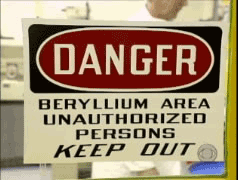
A new assessment finds that Department of Energy (DOE) is not conducting effective oversight of the Los Alamos National Laboratory (LANL) beryllium program, or of safety and health programs in general. In addition, DOE is not maintaining sufficient technical capability and knowledge of site and contractor activities to make informed decisions about hazards and risks. DOE indicated the lack of sufficient safety and health resources has presented a challenge to achieving effective oversight in this area.
Trump fires John Bolton
Washington (CNN) President Donald Trump abruptly announced in a tweet Tuesday that he has asked national security adviser John Bolton to resign, noting that he “strongly disagreed with many” of Bolton’s suggestions “as did others in the administration.”
….I asked John for his resignation, which was given to me this morning. I thank John very much for his service. I will be naming a new National Security Advisor next week.
— Donald J. Trump (@realDonaldTrump) September 10, 2019
September 10 Hans Kristensen of the Federation of American Scientists joins Joe Cirincione to discuss Chinese and Russian nuclear modernization plans, and the state of nuclear arsenals around the world.
Leon Ratz joins Early Warning to discuss Iran’s latest announcement about its nuclear program, Russia’s plans to produce new weapons, and Congress’s return to Washington. Joe Cirincione and Michelle Dover answer a question from Gerrard on how citizens can influence their leaders to support nuclear weapons prohibition.
Listen, Subscribe and Share on iTunes · Spotify · SoundCloud · YouTube · Google Play · Sticher
Also available on ploughshares.org/pressthebutton
Radioactive Barges Are Killing the Vibe on This Russian Beach After Deadly Missile Blast
A pair of pontoon barges suspected of being doused in radioactivity during a deadly nuclear missile accident in Russia washed up on a local beach three weeks ago, where they’ve reportedly been leaking radiation into the sea and sand ever since.
BY GREG WALTERS | vice.com
They landed near the mouth of the Verkhovka river, and have been sitting there with no official warning signs beyond a dirty red shirt stretched between two wooden poles, according local Russian media.
Radiation measurements as high as eight times normal background levels were taken on Aug. 31 from a distance of 150 meters, while earlier tests soon after the pontoons arrived peaked as high as 38 times normal, the outlet said. Those levels are still well short of life-threatening, but measurements closer to the barges haven’t been made.
“No idiots could be found to check the levels on the pontoons themselves without protection,” the local TV presenter deadpanned during a broadcast Monday.
One of the two barges washed up at the mouth of the Verkhovka River a day after the explosion, on Aug. 9. The other was left there by tugboats four days later, Belomorkanal reported.
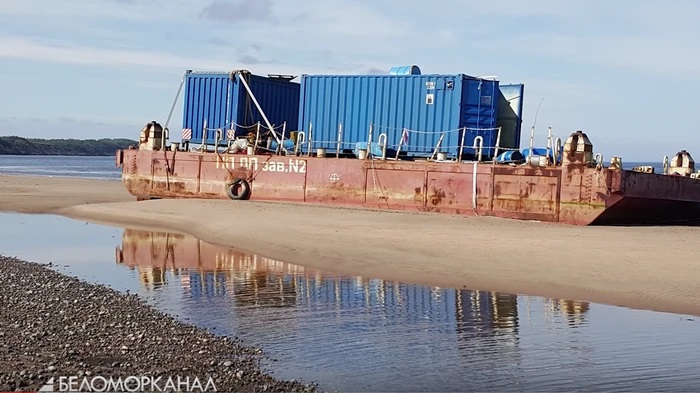
Readings taken on Saturday, Aug. 31 measured from 70 to 186 microroentgen per hour. Earlier measurements in August peaked at 750 microroentgen per hour. Normal local background levels in the area are closer to 20 microroentgen per hour, according to Greenpeace.
There’s not enough data yet to know what the levels are like on the barges themselves.
The U.S. should carefully and prudently maintain its nuclear weapons stockpile
Defense News reports that “Nuclear gravity bomb and warhead upgrades face new delays” because of new components used in so-called Life Extension Programs (LEPs) to prolong the service lives of existing nuclear weapons. These programs also give existing nuclear weapons new military capabilities. For example, see How US nuclear force modernization is undermining strategic stability: The burst-height compensating super-fuze
The point of this blog is to raise the question of whether these Life Extension Programs really enhance U.S. national security while maintaining the safety and reliability of the nuclear weapons stockpile. In fact, perhaps the crux issue is prudent and conservative maintenance of the stockpile versus increasingly aggressive LEPs.

Nuclear Weapons Build-Up Insanity, Los Alamos Lab so-called “Clean-Up” – Jay Coghlan, Nukewatch NM – NH #428
Nuclear weapons – a reminder of what they look like and what they can do.
LISTEN HERE:
Nuclear weapons – their design, engineering, chances for implementation – that’s the topic we explore with Jay Coghlan, Executive Director of Nukewatch NM. Jay goes over the division of responsibility for nuclear weapons of mass destruction between Los Alamos National Laboratory(LANL), Sandia Laboratory, and California’s Lawrence Livermore Lab. He then rips into Department of Energy for the lies and “theatre” surrounding claims of a “more-than-halfway-completed” so-called “clean-up” of LANL that ignores the vast majority of radioactive contamination… and ultimately is funding the new nuclear arms race.
2018
On the 7th Anniversary of Fukushima Disaster, It’s Still a Long Way From Over
7 years on, the decontamination process scheduled for March 2018 has been suspended due to “extremely high” radiation levels (one hour, you’re dead). (ref)
In Surprise Move, Trump Tweets He’ll Meet With Kim Jong Un by May
-
President Donald Trump agrees to meet with North Korean leader Kim Jong Un, a significant development in the decades-long effort to denuclearize the Korean Peninsula.
-
“Great progress being made but sanctions will remain until an agreement is reached,” Trump tweeted Thursday.
- Trump’s decision bypasses the traditional negotiation process in favor of a top-level face-to-face meeting.
Call to action! Comments Against WIPP Expansion Needed By April 3rd
Call to action!
Comments on WIPP Expansion Needed By April 3rd
Informational Meeting Is March 8th
New Mexico is under growing nuclear attack.
· Plutonium pit production increases are planned for Los Alamos.
· There are serious plans for all of the nation’s commercial spent nuclear fuel to head to NM.
· WIPP has a major expansion in the works to allow even more radioactive waste into NM.
Today we ask you to join with others to stop a proposed major Waste Isolation Pilot Plant (WIPP) expansion. Officials at the WIPP are proceeding with a deluge of permit modifications to try to get as much weakening of the Hazardous Waste Permit as they can before 2019.
Because DOE is so far behind emplacing waste at WIPP, including because of the three-year shutdown from the 2014 radiation release, and they are running out of underground space, they want to change the way waste volume is measured. Since the 1970s, DOE has agreed that the amount of waste is the volume of the outer-most container. Now, DOE wants to estimate the amount of waste inside each container and use that lesser amount.
By April 3, we need You to submit written comments opposing DOE’s request. If possible, you can find out more at a public meeting (which isn’t for public comments):
“Clarification” of TRU Mixed Waste Disposal Volume Reporting
Thursday, March 8, 2018 3 – 5 p.m.
Courtyard by Marriott, 3347 Cerrillos Road, Santa Fe, New Mexico
DOE’s request is at: http://wipp.energy.gov/rcradox/rfc/Volume_of_Record.pdf
What to expect at this March 8 meeting:
· Interested people, including NM Environment Department officials, gathered to discuss this issue in one of the smaller conference rooms
· Optional sign-in sheet, and DOE handouts of their presentation
· A presentation of the proposed plan by DOE
· Question and answer period – Make sure you get all your questions answered
· No opportunity for formal public comments
WIPP is now filling Panel 7 (of 10 originally proposed), which is about 70% of the space. But WIPP has only emplaced ~92,700 m3 of waste (about 53% of the 175,564 m3 allowed). DOE has “lost” more than 30,000 m3 of space by its inefficiency and contractor incompetence. Measuring the waste the proposed new way decreases the ‘amount of waste’ emplaced to date by ~26,000 m3.
The proposed modification is controversial and is part of a larger plan to expand WIPP, but is submitted as a Class 2 Permit Modification Request (PMR), which has lesser public input opportunities. The public has opposed WIPP expansion for years and decades. There is significant public concern and interest in the WIPP facility. This PMR should be a Class 3, which includes much more public input, a formal public hearing — a process that could take up to a year.
We will provide sample comments by April 3rd, but your comments are just as important.
The complete Permit Modification Request is here –
http://www.wipp.energy.gov/rcra-com-menu.asp
Class 2 Permit Modification Request Clarification of TRU Mixed Waste Disposal Volume Reporting Waste Isolation Pilot Plant Permit, Number NM4890139088-TSDF dated January 31, 2018
http://www.wipp.energy.gov/rcradox/rfc/18-0308_Redacted_enclosure.pdf
By April 3, please mail or fax or e-mail comments to:
Mr. Ricardo Maestas
New Mexico Environment Department
2905 Rodeo Park Drive East, Building 1
Santa Fe, NM 87505
Fax: 505-476-6030
E-mail: [email protected]

The worrisome aspects of Trump’s Nuclear Posture Review represented the arguments of the “Second Nuclear Age” hawks, i.e. that the world is no longer bi-polar, that the US needs more small nukes widely deployed so as not to be caught with either no response or a strategic response in regional conflicts, where the adversary might doubt we would go strategic. Thus US ‘deterrence’ had weakened. In this view, numerous smaller, widely deployed nukes are meant to sustain ‘deterrence’ into the more chaotic “Second Nuclear Age”.
On the other hand, the Russian response is framed by their overriding anxiety that the US, with its missile defense systems surrounding Russia, and NATO troops on Russian borders, is intent on developing the ability to win a nuclear war with Russia. Russia is afraid of the destabilization of the Cold War strategic equilibrium model, wherein neither side sought an advantage so great that it might consider a surprise attack. ABMs – anti-ballistic missile systems- were banned so that neither side could hope to launch a first strike and take out the remaining retaliatory missiles with a missile defense system.
The Russian high command stated last year that they in fact did now think the US was working to develop this capability (ref). The Trump Nuclear Posture Review, with its emphasis on war-fighting nukes, only reinforced Russian command fears that the US could be preparing for a fight. The weapons systems Putin announced last week were all noted for their ability to defeat missile defenses and thus, in the Russian view, to preserve ‘MAD’- mutually assured destruction- the Cold War’s solution to preventing a nuclear war. To understand better the Russian view, it’s worth remembering what Yuri Andropov said in 1981:
“The US is preparing for war but it is not willing to start a war… They strive for military superiority in order to ‘check’ us and then declare ‘checkmate’ against us without starting a war.” (ref)
Putin’s speech to the Federal Assembly March 1, 2018:
“Back in 2001, the US announced its withdrawal from the Anti-Ballistic Missile Treaty. Russia was categorically against this. We saw the Soviet-US ABM Treaty signed in 1972 as the cornerstone of the international security system…
Together with the Strategic Arms Reduction Treaty, the ABM Treaty not only created an atmosphere of trust but also prevented either party from recklessly using nuclear weapons, which would have endangered humankind, because the limited number of ballistic missile defense systems made the potential aggressor vulnerable to a response strike.
We did our best to dissuade the Americans from withdrawing from the treaty. All in vain. The US pulled out of the treaty in 2002…
Despite our numerous protests and pleas, the American machine has been set into motion, the conveyer belt is moving forward. There are new missile defense systems installed in Alaska and California; as a result of NATO’s expansion to the east, two new missile defense areas were created in Western Europe: one has already been created in Romania, while the deployment of the system in Poland is now almost complete…”
Defeating missile defenses, from Putin’s speech to the Federal Assembly, March 1:
– The Sarmat ICBM “is untroubled by even the most advanced missile defense systems.”
– A nuclear-powered, nuclear-capable cruise missile: “invincible against all existing and prospective missile defense and counter-air defense systems.”
– A high-speed, deep ocean nuclear drone “There is simply nothing in the world capable of withstanding them.”
– The RS-26 “Avangard” (aka YU-71) A nuclear-capable hypersonic glide vehicle that can travel at 20 times the speed of sound. “It flies to its target like a meteorite, like a ball of fire”
The intersection of these two contrasting frames of reference could see misunderstandings, confusion, and conflict. Putin seemed to feel obliged to make a clear warning.
“We are greatly concerned by certain provisions of the revised Nuclear Posture Review, which… reduce the threshold for use of nuclear arms… in response to conventional arms attacks and even to a cyber-threat.”
As such, I see it as my duty to announce the following.
Any use of nuclear weapons against Russia or its allies, weapons of short, medium or any range at all, will be considered a nuclear attack on this country. Retaliation will be immediate, with all the attendant consequences.”
But he continued:
“There should be no doubt about this whatsoever. There is no need to create more threats to the world. Instead, let us sit down at the negotiating table and devise together a new and relevant system of international security and sustainable development for human civilization. We have been saying this all along. All these proposals are still valid. Russia is ready for this.
And in closing,
“I hope that everything that was said today would make any potential aggressor think twice, since unfriendly steps against Russia such as deploying missile defenses and bringing NATO infrastructure closer to the Russian border become ineffective in military terms and entail unjustified costs, making them useless for those promoting these initiatives.
It was our duty to inform our partners of what I said here today under the international commitments Russia had subscribed to. When the time comes, foreign and defense ministry experts will have many opportunities to discuss all these matters with them, if of course our partners so desire.”
Stephen Cohen: How Washington Provoked- and Perhaps Lost- a New Nuclear-Arms Race
The Regional Coalition of LANL Communities: Benefits for the Select Few
According to media reports, Andrea Romero, Executive Director of the Regional Coalition of LANL Communities, is accused of charging some $2,200 dollars of unallowable travel costs, such as alcohol and baseball tickets, while lobbying in Washington, DC for additional funding for the Los Alamos National Laboratory (LANL). She in turn accused the nonprofit group Northern New Mexico Protects of political motivations in revealing these questionable expenses. Romero is running in the Democrat Party primary against incumbent state Rep. Carl Trujillo for Santa Fe County’s 46th district in the state House of Representatives.
Perhaps more serious is the fact that Romero was awarded an undisclosed amount of money by the Venture Acceleration Fund (VAF) for her private business Tall Foods, Tall Goods, a commercial ostrich farm in Ribera, NM. According to a May 8, 2017 Los Alamos Lab news release announcing the award to Tall Foods, Tall Goods, “The VAF was established in 2006 by Los Alamos National Security [LANS], LLC to stimulate the economy by supporting growth-oriented companies.”[1] LANS, primarily composed of the Bechtel Corporation and the University of California, has held the annual ~$2.4 billion Los Alamos National Laboratory (LANL) management contract since June 2006.
The Regional Development Corporation administers the Venture Acceleration Fund.[2] It states that the median VAF award in 2017 was $41,000, and that preference is given to companies that “Have an association with LANL Technology or Expertise.” [3]
It is, at a minimum, unseemly for the Executive Director of the Regional Coalition, which lobbies for increased LANL funding, to receive funding for her private business from LANS, who runs LANL.[4] Ultimately that funding for her private business comes from the American taxpayer.
Romero’s employer, the Regional Coalition, is overwhelmingly funded by the Department of Energy (DOE) and the Los Alamos County government, which receives more than $30 million dollars annually from the Lab through state gross receipts taxes. The Regional Coalition has been lobbying the New Mexico legislature to pass a state law requiring that LANL continue to pay gross receipts tax in the event that its management contract is taken over by a nonprofit university.[5] If successful, that would help to ensure the Regional Coalition’s funding stream.
Concerning the “adequate funding for LANL” that the Regional Coalition lobbies for, LANL’s annual ~$2.4 billion budget is now 70% for core nuclear weapons research and production programs, while much of its remaining funding either directly or indirectly supports those programs. In partial contradiction, the Cities and Counties of Santa Fe and Taos, which belong to the RCLC, have at various times passed resolutions against expanded plutonium pit production for nuclear weapons and/or called for genuine comprehensive cleanup at the Lab.
Despite its rhetoric on producing jobs through cleanup, the Regional Coalition has yet to take a position advocating for genuine comprehensive cleanup at LANL. Instead, the Coalition seems to condone DOE and LANL plans to “cap and cover” and leave ~150,000 cubic meters of radioactive and toxic wastes permanently buried in unlined pits and trenches at the Lab’s largest waste dump, Area G.[6] This will create a permanent nuclear waste dump above the regional groundwater aquifer, three miles uphill from the Rio Grande. Radioactive and toxic wastes are buried directly in the ground without liners, and migration of plutonium has been detected 200 feet below Area G’s surface.[7]
In September 2016 the Department of Energy released a 2016 Lifecycle Cost Estimate Summary[8] of proposed future cleanup at LANL, which RCLC Executive Director Romero hailed as:
The Lifecycle Baseline documentation provides our communities the necessary foundation to properly advocate on behalf of the best possible scenarios for cleaning up legacy nuclear waste at the Laboratory in the most time and cost-efficient manner. After years of requests for this document, we now have the tool that can get us to additional cleanup dollars to get the job done.[9]
However, at the beginning of the 2016 Lifecycle Cost Estimate Summary DOE declares that “An estimated 5,000 cubic meters of legacy waste remains, of which approximately 2,400 cm [cubic meters] is retrievably stored below ground”, a claim which was widely reported in New Mexican media. From there DOE estimated that it would cost $2.9 to $3.8 billion to complete so-called cleanup around 2040, which is woefully low. The DOE report omits any mention of the ~150,000 cubic meters of poorly characterized radioactive and toxic wastes at Area G, an amount 30 times larger than DOE acknowledges. As a partial result, DOE funding for cleanup at LANL remains flat at around $190 million per year, when the New Mexico Environment Department is on record that $250 million per year is needed.
Jay Coghlan, Nuclear Watch Director, commented,
New Mexicans often hear from the Department of Energy and our congressional delegation how nuclear weapons programs economically benefit us. If that’s the case, why is it that New Mexico has fallen from 37th in per capita income in 1957 to 48th in 2017? [10] Why is it that while Los Alamos County is the second richest county in the USA, Main Street Española hasn’t significantly changed for the better in the last 40 years? It’s clear that the economic benefits of the nuclear weapons industry go only to the select few, while to its shame New Mexico as a whole continues to be ranked as the second worst state for children.
# # #
[Copying URLs into browsers is recommended.]
[1] LANL’ s May 8, 2017 news release Six northern New Mexico businesses awarded funds to boost growth is available at http://www.lanl.gov/discover/news-release-archive/2017/May/0518-6-nnm-business-awarded-funds.php
[2] “The RDC [Regional Development Corporation] was incorporated in 1996 to serve as the Department of Energy (DOE) Los Alamos Site “Community Reuse Organization” (CRO). As a CRO, the RDC’s mission is to diversify the economy within the north central New Mexico region. As a result, the RDC maintains a special working relationship with both the DOE and Los Alamos National Laboratory (LANL).” https://rdcnm.org/about/
[3] See https://web.archive.org/web/20190120214344/https://rdcnm.org/vaf/
[4] The mission statement of the Regional Coalition of LANL Communities is
… the Regional Coalition works in partnership to create one voice to ensure national decisions incorporate local needs and concerns. The organization’s focus is community and economic development, site employment, environmental remediation, and adequate funding for LANL. The Regional Coalition of LANL Communities is comprised of nine cities, counties and pueblos surrounding the Department of Energy’s Los Alamos National Laboratory (LANL). https://regionalcoalition.org/about
[5] Four universities are currently vying for the LANL management contract: Purdue (with corporate partner Bechtel), the University of California, the University of Texas, and Texas A&M (DOE Secretary Rick Perry’s alma mater). Corporate partners for the last three have not been disclosed.
[6] Estimated quantities of waste at Area G (in cubic yards) are from Table G3.41, MDA G Corrective Measures Evaluation, 2011, LANS, p. G-13. See excerpts at https://nukewatch.org/importantdocs/resources/Area_G_Pit_Totals_from_CME_rev3_Sept-2011.pdf
[7] Documentation of the plutonium detection 200 feet below the surface of Area G is at https://nukewatch.org/importantdocs/resources/AGCME Plate_B-3_radionuclides_subsurface.pdf
[8] The Department of Energy’s 2016 Lifecycle Cost Estimate Summary for LANL cleanup is available at https://nukewatch.org/importantdocs/resources/LBC-Summary-Aug-2016.pdf
[9] https://web.archive.org/web/20170124153124/http://www.santafenm.gov/news/detail/department_of_energy_release_important_baseline_study
[10] NM per capita income at https://web.archive.org/web/20161206084557/http://www.bea.gov:80/regional/bearfacts/pdf.cfm?
The Regional Coalition of LANL Communities: Benefits for the Select Few
Santa Fe, NM
According to media reports, Andrea Romero, Executive Director of the Regional Coalition of LANL Communities, is accused of charging some $2,200 dollars of unallowable travel costs, such as alcohol and baseball tickets, while lobbying in Washington, DC for additional funding for the Los Alamos National Laboratory (LANL). She in turn accused the nonprofit group Northern New Mexico Protects of political motivations in revealing these questionable expenses. Romero is running in the Democrat Party primary against incumbent state Rep. Carl Trujillo for Santa Fe County’s 46th district in the state House of Representatives.
Perhaps more serious is the fact that Romero was awarded an undisclosed amount of money by the Venture Acceleration Fund (VAF) for her private business Tall Foods, Tall Goods, a commercial ostrich farm in Ribera, NM. According to a May 8, 2017 Los Alamos Lab news release announcing the award to Tall Foods, Tall Goods, “The VAF was established in 2006 by Los Alamos National Security [LANS], LLC to stimulate the economy by supporting growth-oriented companies.”[1] LANS, primarily composed of the Bechtel Corporation and the University of California, has held the annual ~$2.4 billion Los Alamos National Laboratory (LANL) management contract since June 2006.
Major LANL Cleanup Subcontractor Implicated in Fraud; Entire Los Alamos Cleanup Should Be Re-evaluated
On December 17, 2017, the Department of Energy (DOE) awarded a separate $1.4 billion contract for cleanup at the Los Alamos National Laboratory (LANL) to Newport News Nuclear BWXT-Los Alamos, LLC (also known as “N3B”).[1] This award followed a DOE decision to pull cleanup from LANL’s prime contractor, Los Alamos National Security, LLC (LANS), after it sent an improperly prepared radioactive waste drum that ruptured underground at the Waste Isolation Pilot Plant (WIPP). That incident contaminated 21 workers and closed WIPP for nearly three years, costing taxpayers at least $1.5 billion to reopen.
Tetra Tech Inc is a major subcontractor for N3B in the LANL cleanup contract. Tetra Tech is part of Tech2 Solutions, and will be responsible for the groundwater and storm water programs at LANL that are of intense interest to the New Mexico Environment Department and citizen environmentalists.[2] To date, these programs have been supported by several New Mexico small businesses that will be displaced by Tetra Tech.
Serious allegations of fraud by Tetra Tech were raised long before the LANL cleanup contract was awarded. The US Navy found that the company had committed wide spread radiological data falsification, doctored records and supporting documentation, and covered-up fraud at the Hunters Point Naval Shipyard cleanup project in San Francisco, CA. See media links and excerpts below.
The award of the LANL cleanup contract that includes Tetra Tech raises serious questions about the DOE’s contract evaluation and award process, and the Department’s due diligence in reviewing the performance histories of companies bidding for DOE work. To put this in broad perspective, the DOE’s nuclear weapons and cleanup programs have the singular distinction of being on the congressional Government Accountability Office’s High Risk List for fraud, waste and abuse since 1990.
Potential groundwater contamination is of intense interest to New Mexicans. As late as 1996 the Los Alamos Lab was officially declaring that groundwater contamination was impossible because the overlying volcanic tuff was “impermeable.” LANL even went so far as to request a waiver from NMED to not have to monitor groundwater contamination at all (which fortunately NMED denied). What the Lab, which advertises its “scientific excellence,” omitted to say is that the Parajito Plateau’s geology is highly complex and deeply fractured, providing ready pathways for contaminants to reach groundwater. Indeed, in just the last few months Nuclear Watch forced LANL to admit that its chromium hexavalent-6 groundwater contamination plume is much bigger than previously thought.[3]
Scott Kovac, Nuclear Watch Research Director, commented, “It took years for the DOE Environmental Management Office in Los Alamos to put a cleanup contract in place. We are seriously disappointed that there are major problems before the contract even starts. This situation shines a light on the cozy DOE contractor system, where every cleanup site has different combinations of the same contractors. Call it different trees, but the same old monkeys, where the real priority is to profit off of taxpayers dollars before a shovel turns over any waste.”
Jay Coghlan, Nuclear Watch Director, added, “The entire LANL cleanup program needs to be rethought.” In September 2016 DOE released a 2016 Lifecycle Cost Estimate Summary[4] of proposed future cleanup at LANL. At the beginning of that document the Department declared, “An estimated 5,000 cubic meters of legacy waste remains, of which approximately 2,400 cm [cubic meters] is retrievably stored below ground”, which was widely reported in New Mexican media. From there DOE estimated that it will cost $2.9 to $3.8 billion to complete so-called cleanup around 2040, which is woefully low.
However, the DOE report was far from honest. It intentionally omitted any mention of approximately 150,000 cubic meters of poorly characterized radioactive and toxic wastes just at Area G (LANL’s largest waste dump) alone, an amount of wastes 30 times larger than DOE admits in the 2016 Lifecycle Cost Estimate.
In reality, DOE and LANL plan to not clean up Area G, instead installing an “engineered cover” and leaving the wastes permanently buried. This will create a permanent nuclear waste dump above the regional groundwater aquifer, three miles uphill from the Rio Grande. Radioactive and toxic wastes are buried directly in the ground without liners, and migration of plutonium has been detected 200 feet below Area G’s surface.[5]
“In sum,” Coghlan concluded, “DOE should take a cue from the president and tell TetraTech “you’re fired!” Beyond that, after the current governor gets out of the way, the New Mexico Environment Department should completely reevaluate cleanup at LANL and force the Lab to genuinely clean up, which it is failing to do now.”
# # #
Media excerpts (copying URLs into browser is recommended):
June 29, 2017, well before the LANL cleanup contract was awarded- https://www.sfgate.com/bayarea/article/Ex-SF-Navy-shipyard-workers-allege-fraud-in-11257774.php
Ex-SF Navy shipyard workers allege fraud in radiation cleanup By J.K. Dineen Published 9:06 pm, Thursday, June 29, 2017 “The cleanup of radioactive contamination at the Hunters Point Shipyard was marred by widespread fraud, faked soil samples, and a high-pressure culture where speed was valued over accuracy and safety, according to four former site workers…” “Questions over the accuracy of the soil tests emerged in October 2012, when the Navy discovered that some results were inconsistent with results from previous samples collected in the same areas.” “In a statement, Tetra Tech spokesman Charlie MacPherson said the company “emphatically denies the allegations made by individuals at today’s news conference that Tetra Tech engaged in a cover-up of fraud on the Hunters Point Naval Shipyard.”
Jan 31, 2018: https://sf.curbed.com/2018/1/31/16956458/hunters-point-toxic-cleanup-navy-responds-san-francisco
Navy: Do-over of $250 million cleanup at Hunters Point necessary Unknown delay for city’s biggest redevelopment project By Chris Roberts@cbloggy “…According to a review of Tetra Tech’s data, triggered by allegations of fraud first made in 2011 and 2012, as much as half of Tetra tech’s work contains problems. That’s enough for the Navy to lose trust in all of the company’s data, Derek Robinson, the Navy’s coordinator for cleanup at the shipyard, said in an interview on Tuesday. “We’ve lost confidence” in Tetra Tech’s work, said Robinson. “All areas” at the shipyard where Tetra Tech did work will be re-tested, beginning as early as this summer… Problems with Tetra Tech’s data first surfaced in 2011 and 2012, when contractors and workers at the shipyard stepped forward with allegations of fraud…”
Jan 26, 2018 https://sf.curbed.com/2018/1/26/16916742/hunters-point-shipyard-toxic-cleanup Almost half of toxic cleanup at Hunters Point Shipyard is questionable or faked, according to initial review City’s goals for housing, affordable housing in doubt after fraud at city’s biggest redevelopment project “much worse” than thought By Chris Roberts@cbloggy,
[1] See https://energy.gov/em/articles/doe-awards-new-los-alamos-legacy-cleanup-contract
[2] See http://tech2.solutions/projects/lanl/
[3] The dangers of chromium-hexavalent 6 were made famous in the film Erin Brocovitch.
[4] The Department of Energy’s 2016 Lifecycle Cost Estimate Summary for LANL cleanup is available at https://nukewatch.org/importantdocs/resources/LBC-Summary-Aug-2016.pdf
[5] Documentation of the plutonium detection 200 feet below the surface of Area G is at https://nukewatch.org/importantdocs/resources/AGCME Plate_B-3_radionuclides_subsurface.pdf
Major LANL Cleanup Subcontractor Implicated in Fraud – Entire Los Alamos Cleanup Should Be Re-evaluated
Santa Fe, NM
On December 17, 2017, the Department of Energy (DOE) awarded a separate $1.4 billion contract for cleanup at the Los Alamos National Laboratory (LANL) to Newport News Nuclear BWXT-Los Alamos, LLC (also known as “N3B”). This award followed a DOE decision to pull cleanup from LANL’s prime contractor, Los Alamos National Security, LLC (LANS), after it sent an improperly prepared radioactive waste drum that ruptured underground at the Waste Isolation Pilot Plant (WIPP). That incident contaminated 21 workers and closed WIPP for nearly three years, costing taxpayers at least $1.5 billion to reopen.
Tetra Tech Inc is a major subcontractor for N3B in the LANL cleanup contract… Serious allegations of fraud by Tetra Tech were raised long before the LANL cleanup contract was awarded. The US Navy found that the company had committed wide spread radiological data falsification, doctored records and supporting documentation, and covered-up fraud at the Hunters Point Naval Shipyard cleanup project in San Francisco, CA.
Detailed NNSA Budget Documents Accelerates Nuclear Weapons Arms Race
Late Friday February 23 the Trump Administration released the detailed FY 2019 budget for the National Nuclear Security Administration (NNSA), the semi-autonomous nuclear weapons agency within the federal Department of Energy. Overall, NNSA is receiving a $2.2 billion boost to $15.1 billion, a 17% increase above the FY 2018 enacted level. Of that, a full $11 billion is for the budget category [Nuclear] “Weapons Activities”, 18% above the FY 2018 level. Of concern to the American taxpayer, DOE and NNSA nuclear weapons programs have been on the congressional Government Accountability Office’s High Risk List for project mismanagement, fraud, waste and abuse since its inception in 1990.
Under Trump’s budget, funding for nuclear warhead dismantlements stay flat at $56 million, (point).5% of NNSA’s total nuclear weapons budget, despite the fact that dismantlements save taxpayers by eliminating constant security costs.[1] NNSA’s Nonproliferation Programs are budgeted at $1.86 billion, only 16% the size of the nuclear weapons budget. Funding for DOE cleanup of Cold War legacy wastes remains flat, in a number of cases insufficient to meet legal milestones. Meanwhile, the Department of Energy cuts sustainable transportation, renewable energy and energy efficiency by 33%.
Some selected NNSA FY 2019 nuclear weapons budget highlights are:
- Funding is tripled from $218.76 million to $654.77 million for the W80-4 Life Extension Program for a Long Range Standoff nuclear warhead,[2] (slated for $804 million in FY 2022). This is for a new dual-use air launched cruise missile (ALCM), which is particularly destabilizing because ALCMs can evade radar by hugging topography. In addition, the targeted adversary has no way of knowing until it is hit whether the payload is conventional or nuclear. The LRSO nuclear weapon is arguably redundant to the new B61-12 nuclear bomb, to be delivered by the new super-stealthy new B21 Raider heavy bomber (whose astronomical costs are kept classified by the Air Force).
- Funding for the world’s first nuclear smart bomb, the B61-12, is increased from $611.9 million to $794 million, with a First Production Unit scheduled for March 2020. As part of the escalating Cold War II arms race, its main mission is to be forward deployed in NATO countries against Russia.
- The Obama Administration had delayed the Interoperable Warhead (IW) for five years. The IW-1 is very much back as a $53 million FY 2019 budget line item, up from $0 in FY 2018. The NNSA and the nuclear weapons labs are proposing three different types of interoperable warheads, which all together could cost more than $40 billion.
The IW-1 is supposed to be interoperable between the Air Force’s W78 intercontinental ballistic missile warhead and the Navy’s W88 sub-launched warhead. However, a 2012 memo leaked to Nuclear Watch and Tri-Valley CAREs shows that the Navy never supported it.[3] In addition, NNSA is beginning a $3 billion “alteration” to the W88 that will refresh its high explosives and give it a new fuze, making the Navy even less inclined to support the IW. The Interoperable Warhead is a huge make work project for the labs, particularly the Lawrence Livermore National Laboratory.
Nevertheless, the IW is the programmatic drive for expanded production of plutonium pits at the Los Alamos National Laboratory (LANL), which will incur many more billions in costs.
- Trump’s recently released Nuclear Posture Review proposed quick development of a low-yield sub-launched Trident missile warhead. While not yet a separate budget line item, NNSA’s FY 2019 hints at dedicated funding next year:
The 2018 Nuclear Posture Review states that the United States will modify a small quantity of existing SLBM [submarine launched ballistic missiles] warheads to provide a low-yield option in the near-term. As the Nuclear Weapons Council translates policy into military requirements, the Administration will work with Congress for appropriate authorizations and appropriations to develop options that support the modification. (P. 80)
- “Plutonium Sustainment” is nearly doubled from $184 million to $361 million. NNSA’s FY 2019 budget says this will:
[S]upport fabrication of four to five development (DEV) W87 pits… and the selection of a single preferred alternative for plutonium pit production beyond 30 war reserve pits per year… (P. 57)
The increase represents the following:
Supports additional personnel, equipment, and certification activities needed to ramp pit production to meet mandated pit production requirements.
Supports additional infrastructure investments to meet requirements by the Nuclear Weapons Council to produce no fewer than 80 war reserve pits per year. (P. 117)
This is significant for a number of reasons. First, as mentioned above, “plutonium pit production beyond 30 war reserve pits per year” is driven by the Interoperable Warhead, which the Navy doesn’t want and is a radically different design that could prompt a return to full-scale nuclear weapons testing. The existing stockpile does not need pit production. Future production is all about future new nuclear weapons designs.
The W87 pits mentioned above are for the Interoperable Warhead. Inside sources indicate that they will not be exact replicas, but instead may have additional built-in “surety” mechanisms to prevent unauthorized use. A serious concern is that any changes to the pit design could perturb the symmetrical implosion process of the plutonium pit, thereby potentially degrading confidence in weapons reliability.
Finally, there are serious doubts that the Los Alamos National Laboratory, the current site of plutonium pit production, is capable of more producing more than 30 pits per year.[4] This may lead to the relocation of the plutonium pit production mission to the Savannah River Site in South Carolina, or more likely in Nuclear Watch’s view production at both places.[5]
Despite the uncertainty of where future expanded plutonium pit production is going to be located, the Chemistry and Metallurgy Research Replacement Project at LANL is slated to be increased from $181 million in FY 2018 to $235 million in FY 2019. Increasing the plutonium limit 10-fold to 400 grams in the CMRR “Rad Lab” is the main priority, for which NNSA has just issued notice of an environmental assessment.[6] The purpose of the increase is to dramatically expand the Rad Lab’s capabilities for materials characterization[7] and analytical chemistry,[8] all in direct support of expanded plutonium pit production.[9]
- The Uranium Processing Facility (UPF) at the Y-12 Plant near Oak Ridge, TN, is increased to $703 million from $663 million, and is projected to go to $750 million in FY 2021, with construction to start soon. The UPF will produce future thermonuclear components that put the “H” in H-bomb. It was halted after a half-billion design mistake for which no one was held responsible, and a Defense Department estimate that it would cost $19 billion.
NNSA’s FY 2019 budget repeats the original claim that the UPF will cost only $6.5 billion. However, after downscoping the original UPF because of costs, NNSA now omits the costs of continued operations at two dangerous old facilities previously slated for decontamination and decommissioning.[10] Moreover, after a team of Lockheed Martin and Bechtel won the Y-12 management contract, it awarded UPF construction to Bechtel without competition. Bechtel is responsible for some of the biggest cost overruns in the DOE complex, for example the Waste Treatment Facility at Hanford (originally $3.5 billion, now $13.5 billion and may never work).
Jay Coghlan, Nuclear Watch Director, commented, “This rapid arms race build up is not going to make us safer. We don’t need thousands of nuclear weapons to deter North Korea. A new arms race with Russia is a giant step backwards. Further enriching the usual nuclear weapons contractors is the wrong priority when instead taxpayers’ money should be making our schools safe and rebuilding our country.”
# # #
NNSA’s FY 2019 detailed Congressional Budget Request is available at https://energy.gov/sites/prod/files/2018/02/f49/DOE-FY2019-Budget-Volume-1.pdf
[1] Some 2,500 retired nuclear weapons are estimated to be in the dismantlement queue.
[2] “Standoff” means that a B52 carrying the LRSO nuclear weapon can position itself some 1,500 miles from the intended target.
[3] See 2012 Navy memo leaked to Nuclear Watch and Tri-Valley CAREs at https://nukewatch.org/importantdocs/resources/Navy-Memo-W87W88.pdf
[4] It should also be noted that major proposed federal actions are required to have public review and comment under the National Environmental Policy Act (NEPA), followed by an agency’s formal Record of Decision (ROD). After completing a 1996 a Stockpile Stewardship and Management Programmatic Environmental Impact Statement to relocate pit production to LANL from the Rocky Flats Plant, DOE issued a ROD limiting production to 20 pits per year. Nuclear Watch believes that NNSA plans to expand production beyond 20 pits per year require a new programmatic environmental impact statement.
[5] An engineering study, reportedly based on an assumed production rate of 50 pits per year, is reportedly due this week, which may soon clarify this situation (however, it may be classified).
[6] The 30-day public comment period ends March 26, 2018. Comments should be sent to emailed to [email protected] or mailed to NNSA Los Alamos Field Office, ATTN: CMRR Project Management Office, 3747 West Jemez Road, Los Alamos, NM 87544. Nuclear Watch will post sample comments at www.nukewatch.org by March 16.
[7] Materials characterization ensures that the plutonium and/or highly enriched uranium are of sufficient “weapons-grade” to begin pit production to begin with.
[8] Analytical chemistry performs up to a hundred quality control samples per pit as it is being produced.
[9] For more, please see https://nukewatch.org/pressreleases/PR-2-22-18-CMRR_Rad_Lab_draft_EA.pdf
[10] In addition, the independent Defense Nuclear Facilities Safety Board says these two old facilities can never be brought up to modern seismic standards, while a few years ago the US Geologic Survey dramatically raised projected potential seismic risks in eastern Tennessee.
Detailed NNSA Budget Documents Accelerates Nuclear Weapons Arms Race
Santa Fe, NM.
Late Friday February 23, the Trump Administration released the detailed FY 2019 budget for the National Nuclear Security Administration (NNSA), the semi-autonomous nuclear weapons agency within the federal Department of Energy. Overall, NNSA is receiving a $2.2 billion boost to $15.1 billion, a 17% increase above the FY 2018 enacted level. Of that, a full $11 billion is for the budget category [Nuclear] “Weapons Activities”, 18% above the FY 2018 level. Of concern to the American taxpayer, DOE and NNSA nuclear weapons programs have been on the congressional Government Accountability Office’s High Risk List for project mismanagement, fraud, waste and abuse since its inception in 1990.
2017
Nothing Found
It seems we can’t find what you’re looking for. Perhaps searching can help.
2016
Nothing Found
It seems we can’t find what you’re looking for. Perhaps searching can help.
2015
Nothing Found
It seems we can’t find what you’re looking for. Perhaps searching can help.


